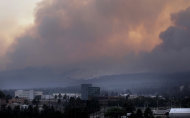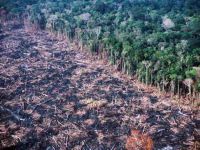LOS ALAMOS, N.M. (AP) — Residents downwind of a wildfire that is threatening the nation's premier nuclear-weapons laboratory are worried about the potential of a radioactive smoke plume if the flames reach thousands of barrels of waste stored in above-ground tents.
Top lab officials and fire managers said they're confident the flames won't reach key buildings or areas where radioactive waste is stored. As a last resort, foam could be sprayed on the barrels containing items that might have been contaminated through contact with radioactive materials to ensure they aren't damaged by fire, they said.
The site's manager for the National Nuclear Security Administration said he evaluated the precautions and felt comfortable. The agency oversees the lab for the Department of Energy.
"I have 170 people who validate their measures," Kevin Smith said. "They're in steel drums, on a concrete floor."
Despite the assurances, some residents remained concerned for the safety of their families and nearby communities.
"If it gets to this contamination, it's over — not just for Los Alamos, but for Santa Fe and all of us in between," said Mai Ting, a resident who lives in the valley below the desert mesas that are home to the Los Alamos National Laboratory.
Chris Valvarde, a resident of the Santa Clara Pueblo about 10 miles north of Los Alamos, questioned officials at a briefing Tuesday evening, asking whether they had evacuation plans for his community. Los Alamos, a town of 11,000, already sits empty after its residents were evacuated ahead of the blaze, which started Sunday.
The wildfire, which has swelled to nearly 95 square miles, has already sparked a spot fire at the lab. The fire Monday was quickly contained, and lab officials said no contamination was released.
Lab Director Charles McMillan said the barrels contain transuranic waste — gloves, toolboxes, tools — and other items that may have been contaminated. Top lab officials declined to say how many barrels were on site or how they are stored. An anti-nuclear group has estimated there could be up to 30,000 gallon-drums.
Los Alamos County Fire Chief Doug Tucker, whose department is responsible for protecting the lab, said the barrels are stacked about three high inside of tents on lab property.
Flames were just across the road from the southern edge of the famed lab, where scientists developed the first atomic bomb during World War II. The facility cut natural gas to some areas as a precaution. The lab will be closed through at least Thursday.
The streets of Los Alamos were empty Tuesday, with the exception of emergency vehicles and National Guard Humvees. Homeowners who had left were prepared: propane bottles were placed at the front of driveways and cars were left in the middle of parking lots, away from anything flammable.
The wildfire has destroyed 30 structures south and west of Los Alamos, for many stirring memories of a blaze in May 2000 that destroyed hundreds of homes and buildings in town.
Favorable winds have helped firefighters, who were busy trying to keep the fire from moving off Pajarito Mountain to the west of Los Alamos and into two narrow canyons that descend into the town and the lab.
"Everything is just so dry and ready to burn," Tucker said. "We need some rain. Snow would be nice." He added that even containment lines had dangerous smoldering stumps and burning roots that could easily ignite fires.
An orange glow on the mountain could be seen from Los Alamos' deserted streets. Some residents who decided to wait out the fire weren't concerned, including Mark Smith, a chemical engineer who works at the lab.
"The risk of exposure is so small. I wouldn't sit here and inhale plutonium. I may be crazy, but I'm not dumb," he said.
The lab, which employs about 15,000 people, covers more than 36 square miles and includes about 2,000 buildings at nearly four dozen sites. They include research facilities, as well as waste disposal sites.
Some facilities, including the administration building, are in Los Alamos, while others are miles from the town. Most of the buildings from the Manhattan Project that developed the first atomic bomb in the 1940s were built on what is now the town and are long gone. The spot fire Monday scorched a section known as Tech Area 49, which was used in the early 1960s for a series of underground tests with high explosives and radioactive materials.
Lab spokesman Kevin Roark said environmental specialists were monitoring air quality, but the main concern was smoke. Lab personnel and the state environment department were monitoring the air for radioactivity and particulates. The state was also working to get additional ground-based monitors and an airborne monitor.
The anti-nuclear watchdog group Concerned Citizens for Nuclear Safety said the fire appeared to be about 3.5 miles from a dumpsite where as many as 30,000 55-gallon drums of plutonium-contaminated waste were stored in fabric tents above ground.
Lab spokeswoman Lisa Rosendorf said a section known as Area G holds drums of cleanup from Cold War-era waste that the lab sends away for storage in weekly shipments.
___
Bryan reported from Albuquerque, N.M. Associated Press writers Barry Massey in Santa Fe and Mark Carlson in Phoenix contributed to this report.
http://beta.news.yahoo.com/towns-near-nm-fire-nuclear-lab-wary-smoke-073221114.html











